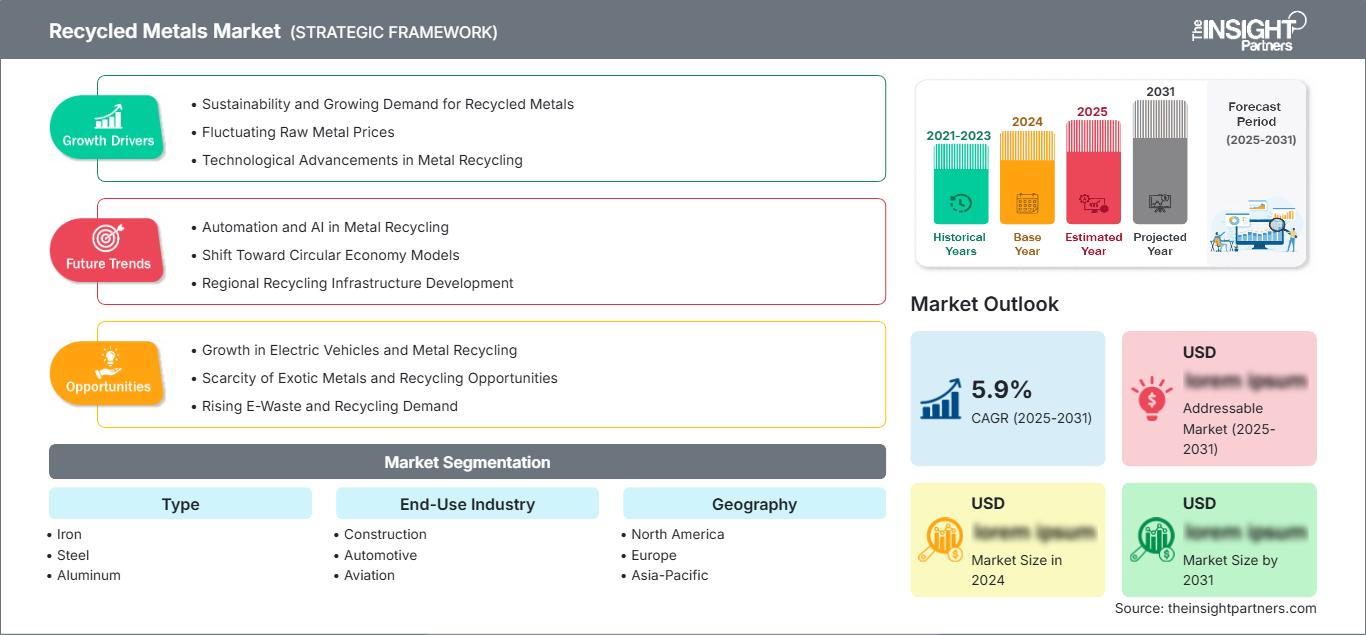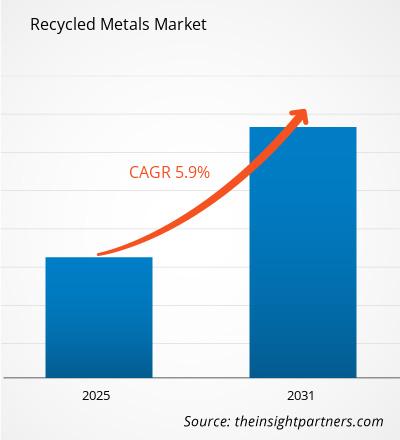Si prevede che il mercato dei metalli riciclati raggiungerà i 502,31 miliardi di dollari entro il 2031. Si prevede che il mercato registrerà un CAGR del 3,6% nel periodo 2025-2031.
Il rapporto è segmentato per tipologia (ferro, acciaio, alluminio, rame, nichel, platino, piombo, stagno e altri). Il rapporto è ulteriormente segmentato per settore di utilizzo finale (edilizia, automotive, aviazione, beni di consumo durevoli, macchinari industriali, imballaggi e altri). L'ambito del rapporto copre cinque regioni: Nord America, Europa, Asia Pacifico, Medio Oriente e Africa, Sud e Centro America e i paesi chiave di ciascuna regione. L'analisi globale è ulteriormente suddivisa a livello regionale e per paesi principali. Il rapporto offre il valore in dollari per l'analisi e i segmenti sopra indicati.
Scopo del rapporto
Il rapporto "Recycled Metals Market" di The Insight Partners mira a descrivere il panorama attuale e la crescita futura, i principali fattori trainanti, le sfide e le opportunità. Ciò fornirà spunti a vari stakeholder aziendali, come:
- Fornitori/produttori di tecnologia: per comprendere le dinamiche di mercato in evoluzione e conoscere le potenziali opportunità di crescita, consentendo loro di prendere decisioni strategiche informate.
- Investitori: per condurre un'analisi completa delle tendenze in merito al tasso di crescita del mercato, alle proiezioni finanziarie del mercato e alle opportunità esistenti lungo la catena del valore.
- Organismi di regolamentazione: per regolamentare le politiche e le attività di controllo nel mercato con l'obiettivo di ridurre al minimo gli abusi, preservare la fiducia degli investitori e sostenere l'integrità e la stabilità del mercato.
Tipo di segmentazione del mercato dei metalli riciclati
- Ferro
- Acciaio
- Alluminio
- Rame
- Nichel
- Platino
- Piombo
- Stagno
Industria di utilizzo finale
- Edilizia
- Automotive
- Aviazione
- Beni di consumo durevoli
- Macchine industriali
- Imballaggio
Potrai personalizzare gratuitamente qualsiasi rapporto, comprese parti di questo rapporto, o analisi a livello di paese, pacchetto dati Excel, oltre a usufruire di grandi offerte e sconti per start-up e università
Mercato dei metalli riciclati: Approfondimenti strategici

-
Ottieni le principali tendenze chiave del mercato di questo rapporto.Questo campione GRATUITO includerà l'analisi dei dati, che vanno dalle tendenze di mercato alle stime e alle previsioni.
Fattori di crescita del mercato dei metalli riciclati
- Sostenibilità e crescente domanda di metalli riciclati: con la diffusione della consapevolezza ambientale, la sostenibilità è oggi sulla bocca di tutti nei settori industriali. Governi, aziende e consumatori stanno diventando sempre più eco-compatibili, il che aumenta la domanda di metalli riciclati. Il riciclo metallurgico preserva le risorse naturali, risparmia energia e riduce gli effetti del degrado ambientale. Normative come le tasse sul carbonio e gli standard di gestione dei rifiuti incoraggiano le aziende ad adottare modelli di economia circolare, stimolando la domanda di metalli riciclati come alternativa ecologica ai metalli vergini.
- Fluttuazioni nei prezzi dei metalli grezzi: le fluttuazioni globali del prezzo dei metalli vergini (alluminio, rame e acciaio) spesso influenzano la domanda di metalli riciclati. Quando i metalli grezzi diventano troppo costosi da estrarre, è meglio riciclarli. La tendenza più recente per questo fenomeno riguarda l'industria automobilistica e quella edile, dove la domanda di metalli rimane elevata e il riciclo dei metalli offre un vantaggio in termini di prezzo, con la sostenibilità come ulteriore vantaggio. Il riciclaggio fornirà stabilità alle aziende con prezzi dei metalli fluttuanti perché offre una catena di approvvigionamento più economica.
- Progressi tecnologici nel riciclaggio dei metalli: i progressi tecnologici nella tecnologia di riciclaggio dei metalli rendono i processi più efficienti con prodotti di qualità superiore. Tecniche di selezione migliorate consentono un utilizzo migliore della separazione automatizzata e una fusione più efficace, garantendo maggiore purezza e resa nei metalli da riciclare. Le innovazioni in questa tecnologia hanno reso il riciclaggio più conveniente, consentendo a un maggior numero di settori di utilizzare i metalli riciclati disponibili in applicazioni di fascia alta, tra cui l'elettronica e il settore automobilistico, che richiedono un'elevata integrità dei materiali. Le nuove tecnologie di riciclaggio rendono l'estrazione di metalli preziosi più economica, migliorando il mercato complessivo.
Tendenze future del mercato dei metalli riciclati
- Automazione e intelligenza artificiale nel riciclaggio dei metalli: le tecnologie di automazione e intelligenza artificiale vengono integrate nel settore del riciclaggio dei metalli per semplificare la selezione, la lavorazione e il trasporto dei rottami metallici. I sistemi di smistamento automatizzati basati sull'intelligenza artificiale e sull'apprendimento automatico migliorano l'identificazione dei metalli con maggiore precisione, migliorando la qualità dei materiali riciclati e riducendo i costi operativi. Le innovazioni apportate da questi progressi stanno rendendo il processo di riciclaggio più rapido e sicuro, un'attrattiva apprezzata sia dai grandi riciclatori che dalle piccole imprese.
- Passaggio a modelli di economia circolare: sempre più settori industriali si stanno orientando verso il modello di economia circolare, in cui non solo riciclano i rottami metallici, ma progettano anche prodotti più facili da riciclare. Questo avviene in molti settori come l'elettronica, l'automotive e il packaging, dove i produttori stanno integrando metalli riciclabili nei loro progetti. Le aziende hanno adottato programmi di ritiro per raccogliere i prodotti usati da riciclare. Questo passaggio a un'economia circolare ha portato i benefici del mercato dei metalli riciclati nell'aumento delle forniture di rottami metallici da riciclare.
- Sviluppo delle infrastrutture regionali per il riciclaggio: nel mercato dei metalli riciclati assumono sempre maggiore importanza le infrastrutture regionali per il riciclaggio e le nazioni, in particolare quelle all'interno dell'Unione Europea e del Nord America, che stanno lavorando per sviluppare capacità di riciclaggio interne più significative per ridurre la loro dipendenza dai rottami metallici importati. La tendenza regionale va di pari passo con la crescente importanza attribuita al contenimento dei costi di trasporto e alla riduzione dell'impronta di carbonio derivante dal trasporto di rottami metallici oltre i confini nazionali.
Opportunità di mercato per i metalli riciclati
- Crescita dei veicoli elettrici e del riciclaggio dei metalli: la crescita dei veicoli elettrici è osservata a livello globale, con conseguente aumento della domanda di alluminio, rame e litio. Questi metalli sono utilizzati nei veicoli elettrici, in particolare nelle batterie e nei motori, e in molti componenti della carrozzeria progettati per ridurre il peso dei veicoli. Il loro riciclaggio può rappresentare un'opportunità per soddisfare la crescente domanda in modo ecologico. È necessario aumentare la disponibilità di metalli riciclati per integrare le scorte minerarie e di conseguenza alleviare gli effetti dell'estrazione di tali metalli.
- Scarsità di metalli rari e opportunità di riciclo: l'aumento del consumo di metalli rari ed rari come litio, cobalto e terre rare nei prodotti elettronici e nelle apparecchiature per le energie rinnovabili offrirà un nuovo mercato per il settore del riciclo. Attualmente non esistono processi di riciclo per questi metalli, ma con il miglioramento della tecnologia, nuove tecnologie potrebbero diventare praticabili per riciclare economicamente questi materiali da apparecchiature elettroniche a fine vita, batterie esaurite e infrastrutture per le energie rinnovabili. Ciò creerebbe una nuova fonte di reddito per il mercato dei metalli riciclati e contribuirebbe alla transizione mondiale verso un'energia più pulita.
- Rifiuti elettronici in aumento e domanda di riciclo: con l'aumento del volume dei rifiuti elettronici a livello globale, un'ampia possibilità di riciclo dei metalli risiede nei dispositivi elettronici di consumo dismessi. I metalli presenti nei rifiuti elettronici includono oro, argento, rame e palladio. Le normative, insieme a una maggiore consapevolezza tra i consumatori, imporranno il miglioramento dei metodi di riciclaggio dei rifiuti elettronici, il che fornirà al mondo una fonte di metalli tanto necessaria, oltre a risolvere i problemi ambientali derivanti dalla produzione di rifiuti elettronici. Con l'avanzare dei paesi verso una legislazione più severa sul riciclaggio dei rifiuti elettronici, un numero maggiore di aziende specializzate in questa nicchia potrà conquistare quote di mercato maggiori.
Mercato dei metalli riciclati
Le tendenze regionali e i fattori che influenzano il mercato dei metalli riciclati durante il periodo di previsione sono stati ampiamente spiegati dagli analisti di The Insight Partners. Questa sezione illustra anche i segmenti e la geografia del mercato della gestione delle malattie del ritmo cardiaco in Nord America, Europa, Asia-Pacifico, Medio Oriente e Africa, America meridionale e centrale.
Ambito del rapporto sul mercato dei metalli riciclati
| Attributo del rapporto | Dettagli |
|---|---|
| Dimensioni del mercato in 2024 | US$ XX Billion |
| Dimensioni del mercato per 2031 | US$ 502.31 Billion |
| CAGR globale (2025 - 2031) | 3.6% |
| Dati storici | 2021-2023 |
| Periodo di previsione | 2025-2031 |
| Segmenti coperti |
By Tipo
|
| Regioni e paesi coperti |
Nord America
|
| Leader di mercato e profili aziendali chiave |
|
Densità degli operatori del mercato dei metalli riciclati: comprendere il suo impatto sulle dinamiche aziendali
Il mercato dei metalli riciclati è in rapida crescita, trainato dalla crescente domanda degli utenti finali, dovuta a fattori quali l'evoluzione delle preferenze dei consumatori, i progressi tecnologici e una maggiore consapevolezza dei vantaggi del prodotto. Con l'aumento della domanda, le aziende stanno ampliando la propria offerta, innovando per soddisfare le esigenze dei consumatori e sfruttando le tendenze emergenti, alimentando ulteriormente la crescita del mercato.

- Ottieni il Mercato dei metalli riciclati Panoramica dei principali attori chiave
Punti di forza
- Copertura completa: il rapporto analizza in modo esaustivo prodotti, servizi, tipologie e utenti finali del mercato dei metalli riciclati, offrendo una panoramica olistica.
- Analisi degli esperti: il rapporto è redatto sulla base della conoscenza approfondita di esperti e analisti del settore.
- Informazioni aggiornate: il rapporto garantisce la pertinenza aziendale grazie alla copertura di informazioni e dati recenti.
- Opzioni di personalizzazione: questo rapporto può essere personalizzato per soddisfare le esigenze specifiche del cliente e adattarsi in modo appropriato alle strategie aziendali.
Il rapporto di ricerca sul mercato dei metalli riciclati può quindi contribuire a guidare il percorso di decodificazione e comprensione dello scenario del settore e delle prospettive di crescita. Sebbene possano esserci alcune valide preoccupazioni, i vantaggi complessivi di questo rapporto tendono a superare gli svantaggi.
- Analisi storica (2 anni), anno base, previsione (7 anni) con CAGR
- Analisi PEST e SWOT
- Valore/volume delle dimensioni del mercato - Globale, Regionale, Nazionale
- Industria e panorama competitivo
- Set di dati Excel
Report recenti
Testimonianze
Motivo dell'acquisto
- Processo decisionale informato
- Comprensione delle dinamiche di mercato
- Analisi competitiva
- Analisi dei clienti
- Previsioni di mercato
- Mitigazione del rischio
- Pianificazione strategica
- Giustificazione degli investimenti
- Identificazione dei mercati emergenti
- Miglioramento delle strategie di marketing
- Aumento dell'efficienza operativa
- Allineamento alle tendenze normative






















 Ottieni un campione gratuito per - Mercato dei metalli riciclati
Ottieni un campione gratuito per - Mercato dei metalli riciclati